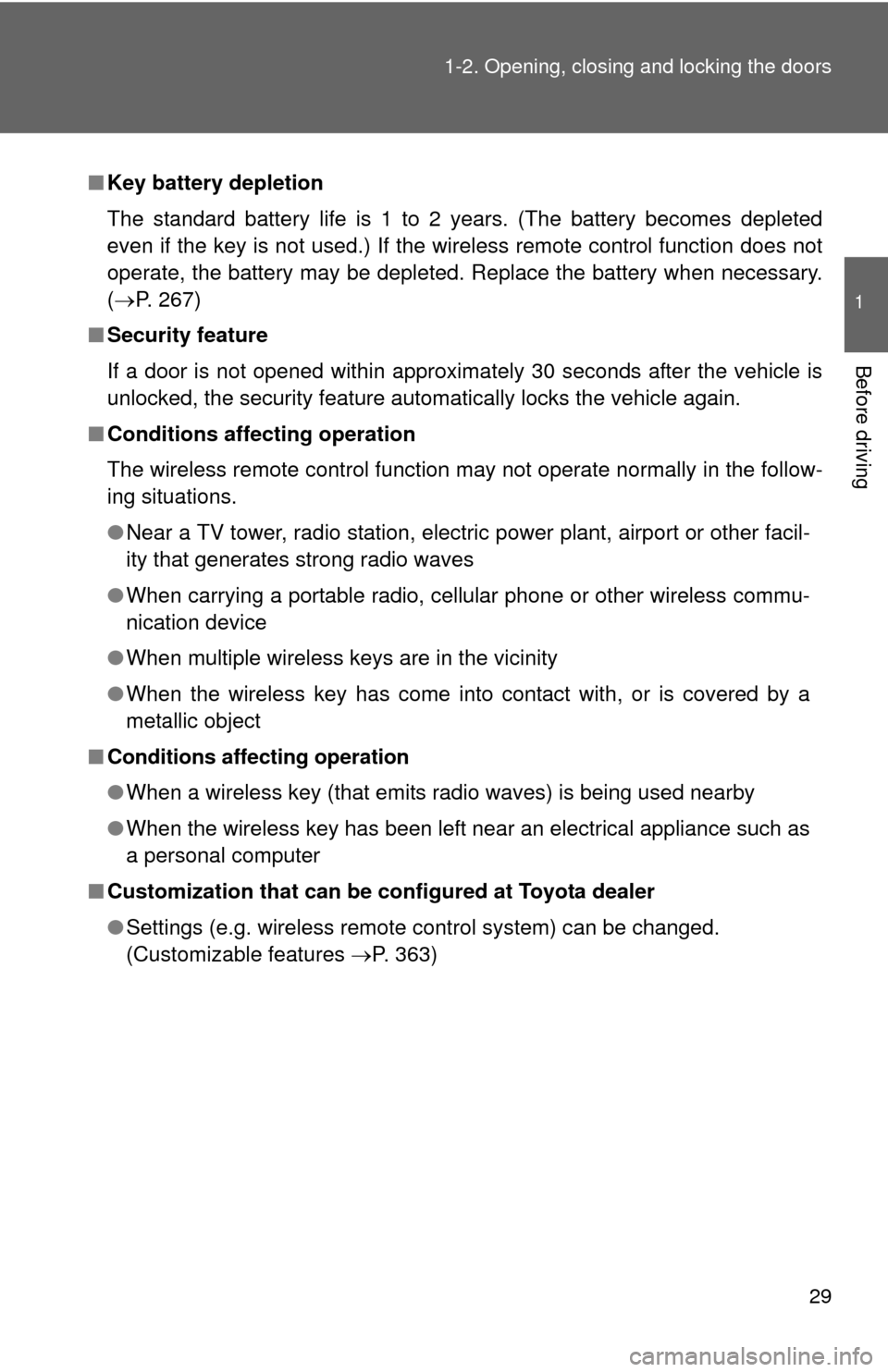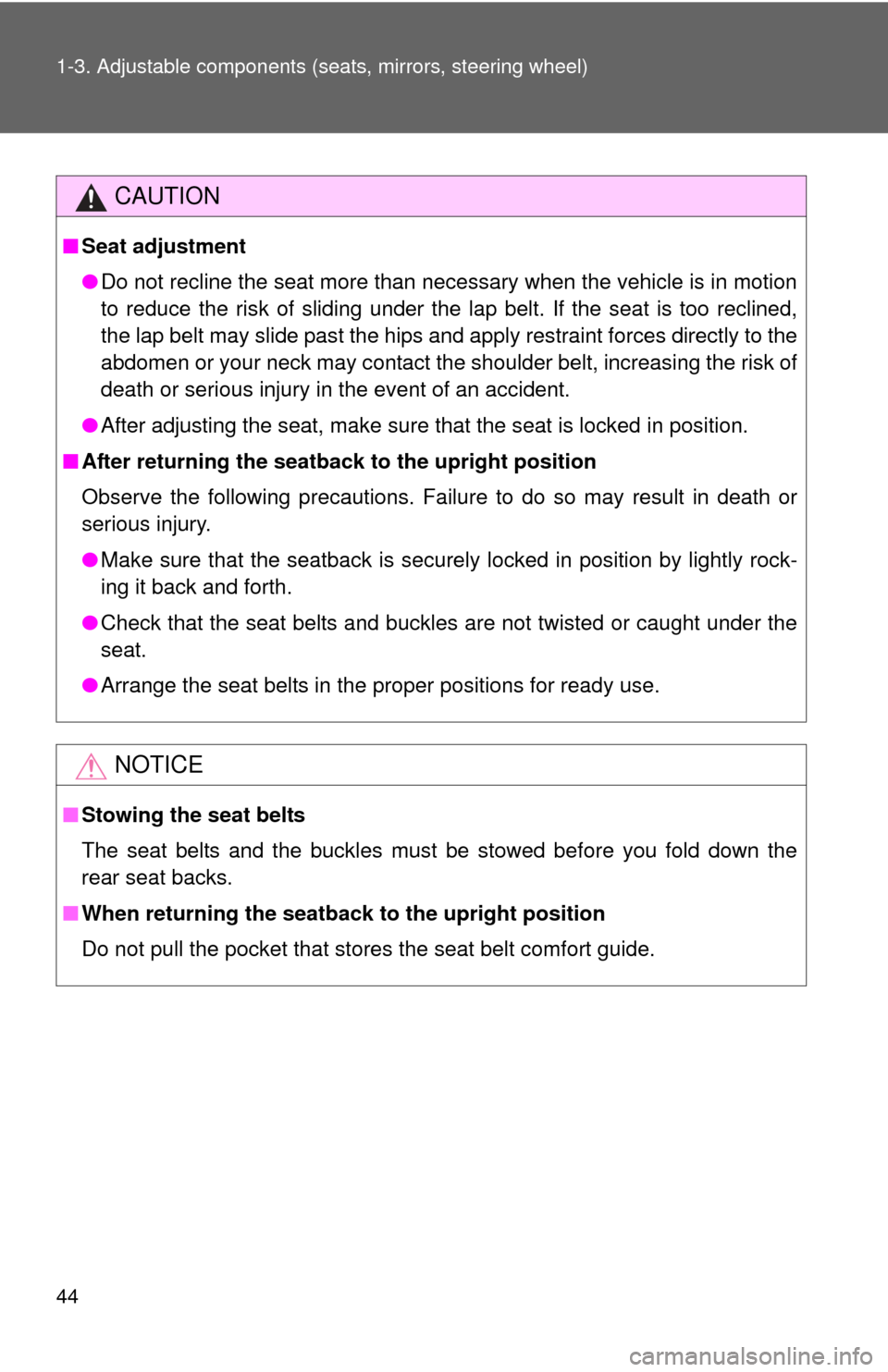Page 1 of 388
TABLE OF CONTENTS
1
1Before drivingAdjusting and operating features such as door locks,
mirrors, and steering column.
2When drivingDriving, stopping and safe-driving information.
3Interior
featuresAir conditioning and audio systems, as well as other in-
terior features for a comfortable driving experience.
4Maintenance
and careCleaning and protecting your vehicle, performing do-it-
yourself maintenance, and maintenance information.
5When trouble
arisesWhat to do if the vehicle needs to be towed, gets a flat
tire, or is involved in an accident.
6Vehicle
specificationsDetailed vehicle information.
7For ownersReporting safety defects for U.S. owners and seat belt
instructions for Canadian owners
IndexAlphabetical listing of information contained in this
manual.
Page 3 of 388

1
2
3
4
5
6
7
3
2-5. Driving information ........... 147Cargo and luggage ............. 147
Vehicle load limits ............... 150
Winter driving tips ............... 151
Trailer towing (except Canada) ............... 155
Trailer towing (Canada) ...... 156
Dinghy towing (vehicles with an automatic
transmission) .................... 164
Dinghy towing (vehicles with a manual
transmission) .................... 165
3-1. Using the air conditioning system and defogger...... 168
Air conditioning system ....... 168
Rear window defogger ........ 175
3-2. Using the audio system.... 176 Audio system types ............. 176
Using the radio .................... 179
Using the cassette player.... 182
Using the CD player ............ 185
Playing back MP3 and WMA discs ........................ 192
Optimal use of the audio system .............................. 200
Using the AUX adapter ....... 203
3-3. Using the interior lights.... 204 Interior lights list .................. 204
• Interior light .......................205
• Personal lights ...................205 3-4. Using the storage
features ........................... 206
List of storage features ....... 206
• Glove boxes ..................... 206
• Cup holders ...................... 208
• Bottle holders ................... 209
• Auxiliary boxes ................. 211
3-5. Other interior features ..... 213 Sun visors........................... 213
Vanity mirrors ..................... 214
Clock .................................. 215
Power outlet ....................... 217
Floor mat ............................ 218
Luggage compartment features ............................ 219
4-1. Maintenance and care ...... 222 Cleaning and protecting the vehicle exterior ................. 222
Cleaning and protecting the vehicle interior .................. 224
4-2. Maintenance...................... 227 Maintenance requirements .................... 227
General maintenance ......... 229
Emission inspection and maintenance (I/M)
programs .......................... 232
3Interior features
4Maintenance and care
Page 4 of 388

TABLE OF CONTENTSIndex
4
4-3. Do-it-yourself maintenance ................... 233
Do-it-yourself service precautions ...................... 233
Hood................................... 236
Positioning a floor jack ....... 237
Engine compartment .......... 239
Tires ................................... 252
Tire inflation pressure......... 258
Wheels ............................... 262
Air conditioning filter ........... 264
Key battery ......................... 267
Checking and replacing fuses ................................ 269
Light bulbs .......................... 280
5-1. Essential information....... 290 If your vehicle needs to be towed ............................... 290
If you think something is wrong ............................... 296
Fuel pump shut off system .............................. 297
Event data recorder............ 298
5-2. Steps to take in an emergency ...................... 300
If a warning light turns on or a warning buzzer
sounds... .......................... 300
If you have a flat tire ........... 310
If the engine will not start ... 323
If the shift lever cannot be shifted from P ................... 325
If you lose your keys .......... 326 If the vehicle battery is
discharged ........................ 327
If your vehicle overheats..... 332
If the vehicle becomes stuck ................................. 335
6-1. Specifications ................... 338 Maintenance data (fuel, oil level, etc.) ........... 338
Fuel information .................. 347
Tire information................... 350
6-2. Customization ................... 363 Customizable features ........ 363
Items to initialize ................. 365
Reporting safety defects for U.S. owners ...................... 368
Seat belt instructions for Canadian owners
(in French) ......................... 369
Abbreviation list ........................ 374
Alphabetical index .................... 375
What to do if... ........................... 383
5When trouble arises
6Vehicle specifications
7For owners
Index
Page 29 of 388

29
1-2. Opening, closing and locking the doors
1
Before driving
■
Key battery depletion
The standard battery life is 1 to 2 years. (The battery becomes depleted
even if the key is not used.) If the wireless remote control function does not
operate, the battery may be depleted. Replace the battery when necessary.
(P. 267)
■ Security feature
If a door is not opened within approximately 30 seconds after the vehicle is
unlocked, the security feature automatically locks the vehicle again.
■ Conditions affecting operation
The wireless remote control function may not operate normally in the follow-
ing situations.
●Near a TV tower, radio station, electr ic power plant, airport or other facil-
ity that generates strong radio waves
● When carrying a portable radio, cell ular phone or other wireless commu-
nication device
● When multiple wireless keys are in the vicinity
● When the wireless key has come into contact with, or is covered by a
metallic object
■Conditions affecting operation
●When a wireless key (that emits radio waves) is being used nearby
● When the wireless key has been left near an electrical appliance such as
a personal computer
■ Customization that can be co nfigured at Toyota dealer
● Settings (e.g. wireless remote control system) can be changed.
(Customizable features P. 363)
Page 41 of 388
41
1-3. Adjustable components (s
eats, mirrors, steering wheel)
1
Before driving
Folding down rear seatbacks
■ Before folding down rear seatbacks
Insert the key into the hole on
the center seat belt buckle to
release tub (with hooked end),
and allow the belt to retract.
Stow the seat belt tabs in the
cover set in the roof as shown.
Page 44 of 388

44 1-3. Adjustable components (seats, mirrors, steering wheel)
CAUTION
■Seat adjustment
●Do not recline the seat more than necessary when the vehicle is in motion
to reduce the risk of sliding under the lap belt. If the seat is too reclined,
the lap belt may slide past the hips and apply restraint forces directly to the
abdomen or your neck may contact the shoulder belt, increasing the risk of
death or serious injury in the event of an accident.
● After adjusting the seat, make sure that the seat is locked in position.
■ After returning the seatback to the upright position
Observe the following precautions. Failure to do so may result in death or
serious injury.
● Make sure that the seatback is securely locked in position by lightly rock-
ing it back and forth.
● Check that the seat belts and buckles are not twisted or caught under the
seat.
● Arrange the seat belts in the proper positions for ready use.
NOTICE
■Stowing the seat belts
The seat belts and the buckles must be stowed before you fold down the
rear seat backs.
■ When returning the seatback to the upright position
Do not pull the pocket that stores the seat belt comfort guide.
Page 47 of 388
47
1-3. Adjustable components (s
eats, mirrors, steering wheel)
1
Before driving
■Adjusting the height of the head restraints
■ Adjusting the rear seat head restraints
Always raise the head restraint one level from the stowed position when
using.
CAUTION
■Head restraint precautions
Observe the following precautions regarding the head restraints. Failure to
do so may result in death or serious injury.
●Use the head restraints designed for each respective seat.
● Adjust the head restraints to the correct position at all times.
● Do not drive with the head restraints removed.
Make sure that the head restraints are
adjusted so that the center of the head
restraint is closest to the top of your ears.
Page 50 of 388
50 1-3. Adjustable components (seats, mirrors, steering wheel)
■Release method
The belt can be completely released when not required, such as
when folding down the rear seat.
To release the hooked end tab,
insert the vehicle’s key into the
hole on the buckle.
Stow the seat belt tabs in the
cover set in the roof as shown.